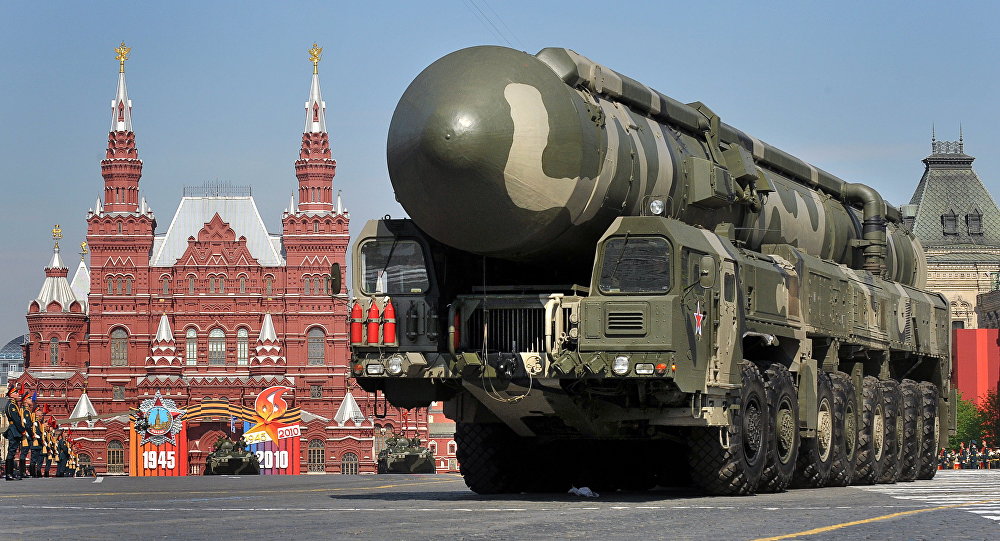The Plutonium Disposition Management Agreement: Russia’s Withdrawal and the Possible Consequences
 In October 2016, Russian President Vladmir Putin suspended the Plutonium Disposition Management Agreement (PDMA) that mandated both the United States and Russia to eliminate a sufficient quantity of weapons grade plutonium. The suspension of the PDMA represents a step away toward achieving nuclear disarmament, a crucial component of the Nuclear Proliferation Treaty (NPT) under Article VI.
In October 2016, Russian President Vladmir Putin suspended the Plutonium Disposition Management Agreement (PDMA) that mandated both the United States and Russia to eliminate a sufficient quantity of weapons grade plutonium. The suspension of the PDMA represents a step away toward achieving nuclear disarmament, a crucial component of the Nuclear Proliferation Treaty (NPT) under Article VI.
The PDMA was signed in 2000 by U.S. Vice President Gore and Russian Prime Minister Kasyanov committing to dispose “no less than 34 metric tons of weapon-grade plutonium.” However, as Russia’s nuclear strategy was announced in 2006, the United States and Russia decided to update the PDMA via a Protocol that would be compatible with Russia’s nuclear strategy. In 2007, the United States and Russia issued a joint statement stating that Russia aspired to use fast neutron reactors for their nuclear energy program and thus, they decided to negotiate the protocol to alter the PDMA accordingly. In 2010, the PDMA was amended by a Protocol signed by then US Secretary of State Hillary Clinton and Russian Foreign Minister Sergey Lavrov. Finally, the PDMA came into force on July 13, 2011.
Weapons grade plutonium can be fabricated into mixed oxide fuel (MOX) and irradiated in civil nuclear power reactors for electricity generation. The agreement itself sought a provision that the plutonium disposed could not be used for nuclear weapons. However, Russia never subscribed to the option of using MOX in light water reactors and as mentioned, went ahead with irradiation of plutonium for fast neutron reactors, of course after seeking concurrence from the United States. The Union of Concerned Scientists had also opposed the MOX project on grounds that it would make it easier for terrorists to “access weapons-usable plutonium.” Mathew Bunn, a nuclear expert with Harvard University, had also opposed the idea of a MOX project as low enriched uranium (LEU) was a better option. The idea was that MOX would “undermine” rather than support the nuclear energy industry in the United States. The MOX process was also expensive and involved a long process. For the United States on the other hand, rather than converting plutonium into nuclear fuel in the down-blending method, the Savannah River Site facility was to be used to dilute plutonium and dispose of at the waste isolation pilot plant in Carlsbad, New Mexico. This “dilute and dispose” option lessened the scope of nuclear terrorism. But Russia was opposed to this method.
Violations and Politics
This is not the first time that the Cold War rivals suspended a legal arrangement or treaty. In 2002, the United States unilaterally withdrew from the Anti-Ballistic Missile (ABM) Treaty and went ahead with the pursuit and deployment of a Ballistic Missile Defence (BMD). Unsurprisingly, the Russians followed suit.
President Putin has cited “unfriendly actions” by the United States as being a “threat to strategic stability” and the reason behind the suspension of the PDMA. What is more, Russia has never been confident of the US options for plutonium disposition. Moscow has however, assured that they would reconsider the PDMA if Washington lifted the sanctions imposed on Russia and paid compensation for the damage incurred. Moscow also demanded for a reduction of US military infrastructure and man power in those NATO countries that joined the alliance post 2000.
Putin’s suspension of the PDMA was no surprise since in April 2016, he accused the United States of not abiding by the protocol and dealing with plutonium in a way that itl could be “retrieved, reprocessed and converted into weapons-grade plutonium.” Naturally, this move of suspending the PDMA is an additional irritant and point of contention between the two nuclear powers.
Russia’s suspension of the PDMA also raises questions surrounding the future of nuclear arms control and disarmament measures. For instance, in 1998, Russia had threatened the United States with withdrawal from the bilateral Highly Enriched Uranium (HEU) Agreement under which Russia had committed to downblend 50 tons of 90 percent enriched uranium that would be recovered from dismantled warheads to the enrichment level of 4-5 percent. In the future, Russia could decide to withdraw from this agreement if tensions with the United States continue to escalate. Another arms control mechanism whose future is at threat is the Intermediate Range Nuclear Forces (INF) Treaty. A treaty in which both parties have eliminated surface-launched nuclear forces of range 500-5000kms from their nuclear arsenals. Both parties to the Treaty have accused each other of violating its terms.
Clearly, the suspension of the PDMA is a risk to the future of nuclear arms control and disarmament and all efforts should be made to compartmentalize nuclear matters from the other disagreements between the United States and Russia.
Debalina Ghoshal is a Research Fellow at the Centre for Human Security Studies. The opinions expressed here are solely hers.
Related posts:
Category: EUROPE & EURASIA, FOREIGN POLICY & SECURITY

